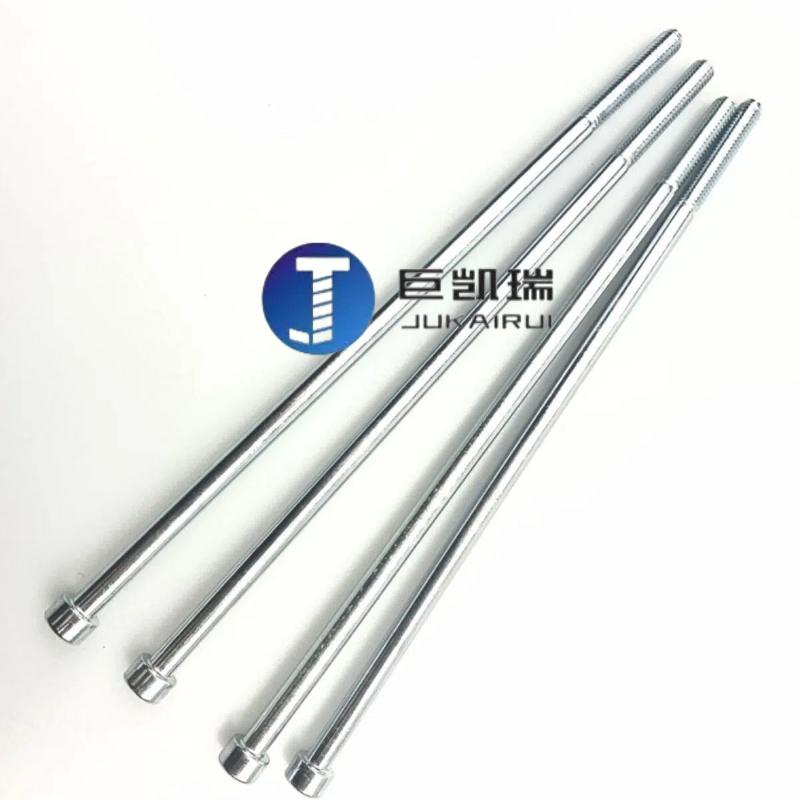Release time:2020-01-16 18:44 Browse:

In extremely cold environments, engineering construction and equipment operation face many challenges, and the correct use of extension screws as a key part of connection and fixing is crucial. The extremely cold environment not only causes difficulties for people's survival and activities, but also has a significant impact on various materials, and lengthening screws are no exception.
First, the effect of low temperature on screw strength
In extremely cold conditions, the strength of the screws will undergo a series of changes. First, as the temperature decreases, the hardness of metal materials usually increases. This means that screws may become more brittle at low temperatures and their impact resistance is reduced. When subjected to dynamic loads, such as vibration or sudden impact of equipment, extension screws in extremely cold environments are more likely to break.
In addition, low temperature will also affect the yield strength and tensile strength of the screws. Generally speaking, within a certain range, the lower the temperature, the yield strength and tensile strength will be increased. However, this increase is not unlimited, when the temperature is reduced to a certain extent, due to the increased brittleness of the material, the screw may break without reaching the expected load.
Low temperature may also cause the thread part of the screw to shrink. This will make the fit between the screw and the nut become tighter, and more force is required when installing and removing. If forcibly installed or removed, it may damage the thread and affect the performance of the screw.
Second, the material selection strategy in extremely cold environment
(1) Choose low-temperature resistant materials
In extremely cold environments, materials with good low temperature resistance should be preferred to make lengthening screws. For example, some grades of stainless steel, such as 316L stainless steel, have good low temperature toughness and corrosion resistance, suitable for use in extremely cold areas. In addition, alloy steel is also a good choice, some special alloy steel after proper heat treatment, can maintain high strength and toughness at low temperatures.
(2) Consider the thermal conductivity of the material
The thermal conductivity of the material also needs to be considered in extremely cold environments. Materials with low thermal conductivity can reduce the transfer of heat and help keep the temperature of the screws relatively stable. For example, some plastics and composites have low thermal conductivity, which can mitigate the effects of low temperatures on screws to a certain extent. However, the strength of these materials is usually low and needs to be balanced according to the specific use requirements.
(3) Pay attention to the cold brittleness of the material
The cold brittleness behavior of different materials is different at low temperature. Some materials become very brittle in extremely cold environments and are prone to fracture. In the selection of materials, we should understand the cold brittleness index by consulting the low temperature performance data of the material, and choose the material with less cold brittleness. For example, some high-strength alloy steels can still maintain good toughness at low temperatures and are ideal for extremely cold environments.
Precautions for use in extremely cold environments
(1) Preparation before installation
Before installing the extension screw, it should be ensured that the surface of the screw and nut is clean and free of impurities such as oil and rust. In extremely cold environments, impurities may cause increased friction between screws and nuts, affecting the installation quality. At the same time, the screws and nuts should be properly preheated. Tools such as a heat gun or heating blanket can be used to heat screws and nuts to a certain temperature to reduce the effect of cold shrinkage. However, it should be noted that the heating temperature should not be too high to avoid damaging the performance of the material.
(2) Operations during installation
During the installation, use a proper tool, such as a torque wrench, to ensure that the tightening torque of the screw meets the requirements. In extremely cold environments, due to the increased hardness of the material, the tightening torque may need to be adjusted appropriately. If the tightening torque is too large, the screw may break or the thread may be damaged. If the tightening torque is too small, the desired connection effect may not be achieved.
In addition, avoid forced installation during the installation process. If it is found that the fit between the screw and the nut is too tight, stop the installation, check the cause and take appropriate measures. Try heating the screws and nuts again, or use a lubricant to reduce friction.
(3) Maintenance during use
When using extension screws in extremely cold environments, regular inspection and maintenance should be carried out. Check the fastening of the screws and tighten them in time if they are loose. At the same time, pay attention to observe whether the surface of the screw cracks, deformation and other abnormal phenomena. If the problem is found, the screw should be replaced in time to ensure the safe operation of the equipment.
In addition, in an extremely cold environment, there may be a large temperature change during the start and stop of the equipment, which has a greater impact on the lengthening screw. Therefore, when the equipment starts and stops, it should be carried out as slowly as possible to reduce the impact of temperature changes on the screws.
In short, the use of lengthening screws in extremely cold environments requires full consideration of the impact of low temperature on the strength of screws, and the selection of appropriate materials and correct use methods. Through reasonable material selection, correct installation and regular maintenance, it can ensure that the extension screw plays a stable connection and fixing role in the extremely cold environment, providing a reliable guarantee for engineering construction and equipment operation.
# Lengthening screws # Lengthening bolts # Lengthening outer hex screws # Lengthening inner hex screws # fasteners

